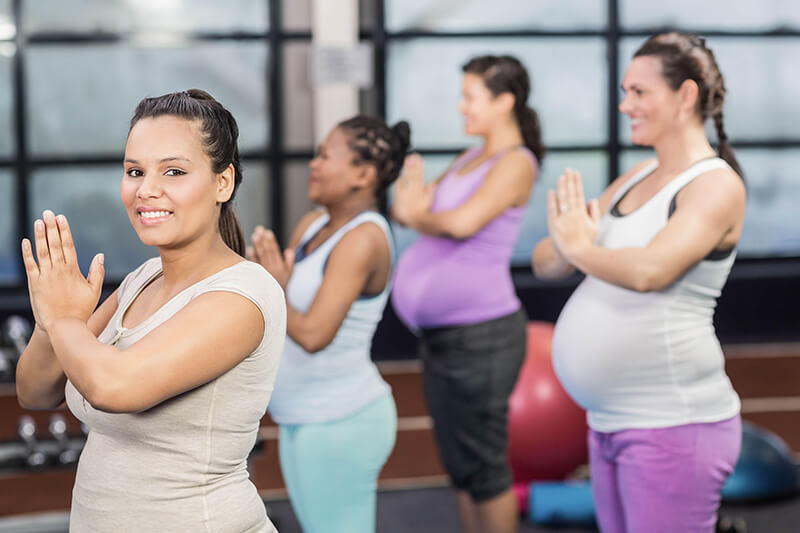
Last updated:
Musculoskeletal physiotherapist Marika Hart from Dynamic Strength Physiotherapy shared with us practical ways to relieve common aches and pains.
Round ligament pain
This pain in the lower abdomen usually crops up in the second trimester and is felt in the lower abdomen/groin area. Many
women report that it’s most uncomfortable in transitional movements such as getting up from a chair or in/out of a car.
Thankfully it is usually short lasting and tends to disappear within a couple of weeks.
What can help
Some women find that abdominal support (such as shorts or tummy bands with gentle compression) can be helpful, but many women
find that movement and gentle stretches can help relieve the pain. Examples of movements that may help include:
- Gently activating your deep abdominal support muscles and/or hugging your lower tummy prior to changing positions
- Hip flexor stretches
- Pelvic tilts can also provide relief
Pubic symphysis
Often described as being “stabbed in the groin by a knife,” this pain can start any time in pregnancy, but often occurs in
the second trimester. Typically, activities such as walking, standing on one leg, getting in/out of a car, rolling in
bed and going up/down stairs will aggravate the pain.
What can help
A physiotherapist can help with education on how to modify exercises and activities. Common tips include:
- Keeping your knees together when rolling in bed
- Sitting down to put shoes and socks on
- Minimising exercises standing on one leg
Manual therapy (for example, massage and joint mobilisation), dry needling and the use of support belts can all be beneficial for relieving
pain.
So too can exercise therapy, including modified yoga or Pilates and hydrotherapy. As with any pain, it’s recommended to seek
the help of your healthcare provider.
Sacroiliac joint (SIJ)
This is often described as “a pain in my butt” or “sciatica” and tends to be aggravated by similar movements as pubic symphysis.
What can help
A physiotherapist can help you find positions and movements that are more comfortable for you. This might include using pillows
to support your top leg when sleeping (which can help to reduce night pain) or modify everyday exercises and activities
around the house to make them less painful.
Like with pubic symphysis pain, hands-on treatment and support belts can help. Most women with SIJ pain benefit from strength
training, so seeing your physiotherapist for an individualised program is ideal.

Lower back pain
This is often experienced in the lumbar region around the peak of the lordosis (inward curve). Some women find that as their
pregnancy progresses, standing and walking for long periods becomes uncomfortable. For others it is sitting that is problematic.
What can help
Low back pain can affect up to two thirds of women during pregnancy. As with back pain at any time, a physiotherapist can help you
find movements and positions that are more comfortable or even pain-relieving. They can use hands-on treatment and
exercise to get you moving and feeling better!
If you do experience back pain, see if you can find a different way of performing a task that is less aggravating. Often,
changing positions if you have been still for a long time can help. Some simple stretches that can be useful for back
pain in pregnancy include:
- Child’s pose
- Pigeon pose
- Cat-cow pose
- Thread-the-needle
Carpal tunnel syndrome
This is common in the final trimester and usually as a consequence of increased fluid retention in the wrist and hand. Symptoms
result from compression of the median nerve as it travels through the wrist (carpal tunnel) and are usually experienced
as numbness and tingling in the hand (often on the palm side in the thumb, index and middle finger) and sometimes pain.
Sleeping is often problematic due to the wrist staying in a flexed position for long periods.
What can help
A physiotherapist or an occupational therapist specialising in hand therapy can help you if you have carpal tunnel syndrome.
Treatment often includes the provision of a wrist splint and exercises that glide the nerves (nerve “flossing”) and reduce
pressure throughout the arm, wrist and upper back. A useful movement that can help is curling your fingers into a fist while also bending your wrists toward your palms. Then slowly straighten your fingers and stretch your wrist in the other
direction.
Pelvic floor dysfunction
Pelvic floor dysfunction is common in pregnancy and in the postnatal period. Symptoms can include stress urinary incontinence
(leakage of urine with coughing, sneezing or exercising), heaviness in the perineum or pain with intercourse.
What can help
We are very fortunate to have many specially trained women’s health physiotherapists, who can assess and treat pelvic
floor dysfunction at any stage in life. Treatment can include pelvic floor exercises, modification of activities, bladder/bowel
advice and manual therapy.
Get 60% back on physio, chiro and osteo
Enjoy great benefits from any provider you like with Flex 60 Extras.